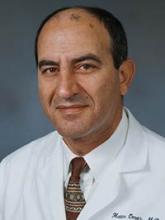Teen suicide is preventable: Here’s how you can help


Written by Dr. Hatim Omar, chief of the UK Adolescent Medicine. Dr. Omar and his team address the unique health concerns faced by teens and young adults.
This Sunday, Sept. 10, is World Suicide Prevention Day, which gives us all an opportunity to think about the ways we can help prevent suicide and show support for the loved ones in our lives.
This is an especially important topic for adolescents, an age group where suicide is a significant cause of death. The statistics are sobering:
- Suicide is the second-leading cause of death among teenagers ages 15-19.
- Suicide is at an all-time high among middle schoolers ages 10-14 and has surpassed car crashes as the leading cause of death.
- Overall, teen suicide has tripled in the last 50 years, killing more teens than all diseases combined.
Why is suicide risk so high among adolescents?
Research shows that there are many factors beyond genetic predisposition and mental illness that influence suicide risk during adolescence.
The adolescent phase is associated with physical, emotional and social changes. Lack of family support, unrealistic expectations, academic pressure, social isolation and victimization can lead to disappointment, depression or simple overreaction that may result in a self-inflicted injury or death.
Other risk factors for teens include:
- Having access to a firearm.
- Being a victim of dating violence and/or sexual assault.
- Being bullied, either at school or cyberbullying.
- Using or abusing drugs or alcohol.
- Having a conflict with a parent.
- Lacking a support system or someone to talk to.
Recognize the warning signs
Be aware of the following warning signs and behaviors that could indicate a teen is at risk for suicide:
- Talking about wanting to die or about feeling trapped.
- Acting anxious or agitated.
- Behaving recklessly.
- Experiencing changes in mood, diet or sleeping patterns.
- Becoming socially isolated.
- Declining school performance.
- Giving away belongings.
- Creating poems, essays or drawings that refer to death.
- Dramatically changing their appearance.
- Expressing a sense of guilt, shame or rejection.
- Talking about feeling unbearable pain, or feeling like a burden to others
Understand the common myths about suicide
Myth 1: Asking someone about suicide will cause him to become suicidal. Asking about suicide can actually help prevent it.
Myth 2: Depression causes all suicides. Less than half of teens who commit suicide have a proven diagnosis of depression and only a fraction of depressed teens commit suicide.
Myth 3: Suicides always happen in an impulsive moment. Many teens will plan a suicide for a long time, often seeking help or trying to attract attention before acting.
Myth 4: Young children cannot be suicidal. They can be, and there is evidence of kids as young as 5 committing suicide
Myth 5: We cannot really prevent suicides. If we all work together, we can reduce suicide significantly. Our grassroots program, Stop Youth Suicide Campaign, has helped more than 20,000 teens over the last 18 years.
How you can help
We all, regardless of our education level or profession, can help prevent and reduce teen suicide. Here’s how:
- Talk to your teens on regular basis. Ask them about their feelings, their conflicts, possible bullying and anything else going on in their lives.
- Make sure there are no means of suicide available at home, especially firearms. Having a firearm at home, even with no other risk factors, increases suicide risk fivefold.
- Show love and support, not punishment or ignorance, when your teen shares something with you.
- Assure your teen that you are always there for them and listen to their issues.
Next steps:
- The team at UK Adolescent Medicine has expertise in a wide range of adolescent concerns. We work to address each patient’s unique emotional, physical and psychological needs. Learn more.
- Want to learn more about helping the teen in your life? Check out these other blogs by our Adolescent Medicine team: Helping LGBTQ teens navigate adolescence; Addressing headaches during the teenage years; Being proactive about teen pregnancy prevention and awareness. And check back regularly for additional topics.




